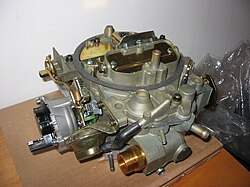Quadrajet
In automobile mechanics, the Quadrajet is a 4 barrel carburetor made by the Rochester Products Division of GM that was widely used in General Motors motor vehicles until 1990. Its last application was on the Oldsmobile 307 V8 engine, which was last used in the Cadillac Brougham and full size station wagons made by Chevrolet, Pontiac, Oldsmobile, and Buick.
The Quadrajet has been described as one of the best carburetors made for passenger vehicles, offering the best compromise of fuel economy, performance, driveability, and automobile emissions control.[citation needed]
Design
The Quadrajet is a "spread bore" carburetor; the primary venturis are much smaller than the secondary venturis. By comparison, a "square bore" carburetor has primary and secondary venturis of similar if not exactly the same size. Most Quadrajets use a vacuum operated piston to move the primary metering rods to control the air fuel ratio, allowing the mixture to be lean under low load conditions and rich during high load conditions. A less-common version uses a linkage driven off the primary throttle shaft to mechanically move the power piston. "E" (Electronic, computer-controlled) series of Quadrajets use a computer controlled Mixture Control Solenoid that provides additional "trim" fuel. The normal jets and passages get the fuel mixture close to what it needs to be, then the solenoid is pulse width modulated at about 10 Hz to fine-tune the air fuel ratio under closed loop conditions. The electronic versions have a throttle position sensor built-in to the carburetor body, actuated by the accelerator pump lever.
Quadrajet carburetors have mechanical secondary throttle plates operated by a progressive linkage (primaries open before secondaries) but use "on-demand" air valve plates above the secondary throttle plates. The air valves are connected by a cam and linkage to the secondary fuel metering rods. As the airflow increases through the secondary bores, the air valves are pushed down, rotating a cam that lifts the secondary metering rods. The secondary rods are tapered in a similar fashion to the primary metering rods, effectively increasing the size of the fuel metering holes as the rods are lifted and delivering more fuel. Therefore, the position of the air valve will control both fuel and air flow through the secondary venturis, even if the secondary throttle plates are fully opened. The end result is that the Quadrajet acts like a "vacuum secondary" carburetor and only deliver more fuel as it is needed.
Drawbacks
This article possibly contains original research. (September 2007) |

Significant negative features of the Quadrajet were:
- Its leaky fuel bowl. As in nealy all carburetors, the Quadrajet's bowl had pressed-in plugs used to seal holes left after drilling fuel passages during the manufacturing of the carburetor. These plugs in the Q-jet sometimes leaked fuel causing; (A) a cold engine being hard to start, (B) erratic idling, (C) poor fuel mileage, and (D) excessive emissions. Many Quadrajets have their fuel bowl plugs sealed with epoxy when rebuilt to prevent leaks.
- The very small float bowl/fuel chamber can result in fuel starvation in extreme high-performance situations, but can usually be traced to a fuel delivery problem to the carburetor, such as a worn fuel pump or camshaft. In normal driving and mild performance use it provides excellent control of fuel level.
- The fuel inlet/fuel filter housing threads tend to be very fragile. It is common for the fuel inlet threads in the main casting to strip. There are several "fixes" available in the aftermarket: New oversize self-tapping fuel filter housings; new fuel filter housings that seal with O-rings; and Heli-Coil rethreading kits.
- Almost all Quadrajets today have some amount of warpage of the castings. The root cause of this warpage is over-tightening the front two carburetor mounting bolts, often in combination with a base gasket that doesn't have hard nylon inserts for the bolt holes.
- The steel primary throttle shaft will tend to wear the throttle body aluminum casting material. This results in an air leak and in extreme cases could cause the primary throttle blades to not close properly. This results in poor idle quality. The aftermarket has responded; several vendors are supplying repair kits for the throttle body.
- The Quadrajet was original equipment on everything from six-cylinder "V-6" engines to 500 cubic inch V-8s. To meet the wide disparity of applications; and to meet more stringent emissions control regulations, over the years there have been a huge number of variations in fuel passages, air passages, vacuum ports, control methods for the secondary air valve, choke designs; and so forth.
Variants
A major change to the Quadrajet was implemented for the 1975 model year. These newer carburetors are considered "Modified Quadrajets" or "Mod Quads". In addition to the casting revisions that result in a physically larger carburetor, the primary metering rod length is different from '74 and older Q-Jets. They were also equipped with a self contained choke mechanism that no longer relied on an intake manifold mounted choke, and a number "1" was added to the beginning of their identification numbers.
Quadrajet carburetors were also built under contract by Carter. This seems to have happened at times when Rochester's facility could not keep up with demand. Carter-built Quadrajets will have the name "Carter" cast into them, but are functionally identical to the Rochester-built equivalent. The "newest" Q-Jets were built for, and sold by Edelbrock. There were several versions made, for both stock replacement and "performance" applications. One version was specifically intended as a replacement for Carter Thermoquad carburetors. The Edelbrock Q-Jets have been discontinued, although at this time Edelbrock still supplies some replacement parts.
